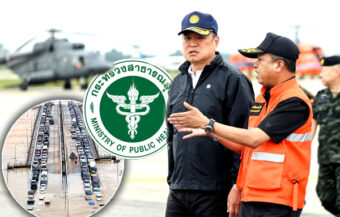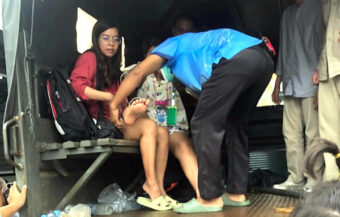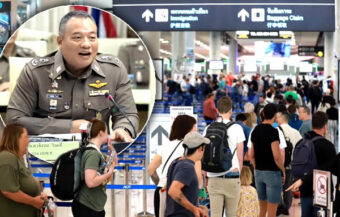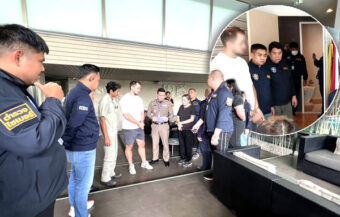The Royal Thai Army is set to build a 10km wall along the Thai-Cambodian border to halt illegal crossings, block scam networks and smugglers and secure one of Thailand’s busiest, most porous border zones before construction begins later this year.
The Royal Thai Army is pushing ahead with plans to build a 10-kilometre wall along the Thai-Cambodian border, targeting a stretch that is not under dispute. This move marks a sharp escalation in efforts to seal off one of Thailand’s busiest and most porous crossings, located in Aranyaprathet District—a hotspot long plagued by illegal entry and criminal activity. Last Thursday, the Chief of Staff of the Royal Thai Armed Forces oversaw a survey team as it began groundwork for construction. The permanent barrier is part of a larger, no-nonsense strategy to lock down the entire border. In contested areas where a wall isn’t yet possible, the army is already rolling out temporary fencing to tighten control.
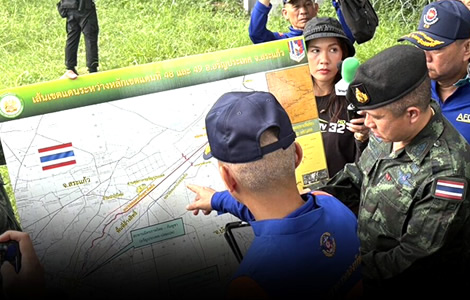
The Royal Thai Army has officially approved the construction of a 10-kilometre border wall in Aranyaprathet District in Sa Kaeo Province. This new barrier will run between Boundary Markers 50 and 51 along the Thai-Cambodian border. Construction is expected to begin before the end of this year.
On Thursday, August 28, General Manas Chandi, Chief of Staff at the Royal Thai Armed Forces Headquarters, led a field survey. His team inspected the area from Boundary Marker 48 to 51 in Sa Kaeo Province. This area stretches from Ban Pa Rai to Ban Tha Kham and lies along a known border route.
Army field inspections confirm the location of first phase of a permanent Thai-Cambodian border wall project
The visit was not routine. Instead, it was a direct step to prepare for one of Thailand’s most significant border fortification projects in recent years. The military confirmed that construction would begin where both Thailand and Cambodia agree on the boundary line. This makes the section at Markers 50 and 51 the logical starting point for a permanent wall.
Moreover, the planned structure is not symbolic. It will be a solid, physical barrier spanning 10 kilometres, designed to halt illegal movement. In addition, it will include road access to allow for regular patrols by military personnel. These features will significantly strengthen Thai control in this area.
In areas where the boundary remains disputed, the army will not yet build permanent structures. Instead, temporary security measures will be installed. These include triple-layer concertina wire, access roads, and surveillance cameras. Where conditions allow, CCTV systems will be added to enhance monitoring.
Temporary fences and surveillance gear to secure disputed zones before permanent borders are negotiated
Consequently, these measures will allow forces to respond quickly to suspicious activity or breaches. They also serve to mark Thai territory more clearly, even in areas without official border agreements. This approach allows Thailand to move forward while maintaining flexibility in unresolved zones.
Security officials believe this project will deliver clear results. It will disrupt illegal crossings, close loopholes and stop unauthorised entry through forest paths and remote terrain. Most notably, it targets the networks that use natural channels for criminal operations.
In recent years, border crossings in this area have been exploited by scam syndicates. These include call centre gangs and transnational criminal groups. As a result, public concern has grown. Many citizens see border security as a national priority.
Furthermore, the project is being pushed through with urgency. Officials confirmed that once the National Security Council approves the plan, construction will begin immediately. There are no funding delays, according to the military. Budget allocations are already prepared and the government sees no obstacles ahead.
Wall plan advances swiftly as officials confirm funding readiness and mounting public support for action
However, officials acknowledged that some land areas may be affected. They plan to conduct detailed surveys to assess the wall’s impact on local communities. Even so, the government believes the public will support the project. The military says many people are willing to make sacrifices for national security.
In fact, support from local citizens has been vocal. Many residents in border provinces have reportedly offered donations to help fund the wall. These offers reflect strong public sentiment in favour of tighter border controls.
Maj. Gen. Wanchana Sawatdee, Director of the Office of Security Coordination at the Internal Security Operations Command, addressed this directly. He confirmed that the construction was in response to public demand. He also expressed gratitude to those offering financial support. However, he noted that legal procedures must be reviewed before public contributions can be accepted.
Public support for the wall grows as citizens offer donations, but legal hurdles may delay contributions
Even so, the military sees this as a sign of nationwide support. The project is no longer just a government decision—it is also a people’s demand. This adds political momentum to a security initiative already backed by top leadership.
Strategically, the wall sends a clear message. Thailand is reinforcing its borders and refusing to tolerate cross-border crime. At the same time, it is taking care not to escalate tensions with neighbouring Cambodia. By focusing first on areas with agreed demarcation, Thailand avoids diplomatic friction while acting on its own priorities.
In practical terms, this wall is more than a fence. It is a military-grade barrier. It will come with built-in surveillance and support infrastructure. Patrol routes will ensure 24-hour monitoring, and the installation of cameras will help detect movement at all times.
Strategic barrier aims to shut down criminal entry while avoiding conflict with neighbouring Cambodia
In the long run, the Thai military believes this model could expand to other parts of the border. But this will depend on further negotiations and territorial clarity. For now, the government plans to begin where it can act unilaterally—and where threats are most acute.
Tensions flare on Cambodian border at Sa Kaeo with locals herded by officials to confront Thai soldiers
Cambodians and scammers risk all to get back into Thailand across a closed and dangerous border
Therefore, the wall represents a major shift in Thailand’s border strategy. It reflects new thinking, stronger resolve and a readiness to act decisively. If successful, the Aranyaprathet wall may become a model for future action along the entire Thai-Cambodian border.
With budget, leadership, and public support aligned, construction is likely to begin within months. The Thai Army is no longer simply monitoring the border. It is securing it—permanently.
Join the Thai News forum, follow Thai Examiner on Facebook here
Receive all our stories as they come out on Telegram here
Follow Thai Examiner here
Further reading:
US turns down Thai request for advanced F35 fighter jets but offers less expensive F16s and F15s
China could be an economic time bomb sitting on Thailand’s doorstep as Evergrande collapse nears


